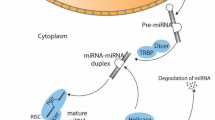Abstract
MicroRNAs (miRNAs) are known to regulate post-transcriptional gene expression. They are involved in carcinogenesis and tumor progression. The aim of this study was to explore the microRNA-mRNA regulatory network in esophageal squamous cell carcinoma (ESCC) using comprehensive computational approaches. In this study we have selected a total of 11 miRNAs from one previously reported study in ESCC. The mRNA targets of these miRNAs were predicted using various algorithms. The expression profiles of these mRNA targets were identified on DNA microarray experiment dataset across ESCC tissue samples. Based on the miRNA-mRNA regulatory relationships, the network was inferred. A total of 23 miRNA-mRNA regulatory interactions, with 11 miRNAs and 13 mRNA targets, were inferred in ESCC. The miRNA-mRNA regulatory network with increased confidence provides insights into the progression of ESCC and may serve as a biomarker for prognosis or the aggressiveness of ESCC. However, the results should be examined with further experimental validation.
Similar content being viewed by others
References
Kamangar F. Patterns of cancer incidence, mortality, and prevalence across five continents: defining priorities to reduce cancer disparities in different geographic regions of the world. J Clin Oncol, 2006,24(14):2137–2150
Jemal A, Siegel R, Xu J, et al. Cancer statistics, 2010. CA Cancer J Clin, 2010,60(5):277–300
Bushati N, Cohen S. microRNA functions. Annu Rev Cell Dev Biol, 2007,2(3):175–205
Baek D, Villén J, Shin C, et al. The impact of microRNAs on protein output. Nature, 2008,455(7209):64–71
Bartel D. MicroRNAs: genomics, biogenesis, mechanism, and function. Cell, 2004,116(2):281–297
Calin G, Dumitru C. Frequent deletions and down-regulation of micro-RNA genes miR15 and miR16 at 13q14 in chronic lymphocytic leukemia. Proc Natl Acad Sci USA, 2002,99(24):15524–15529
Davis-Dusenbery B, Hata A. MicroRNA in ancer: The involvement of aberrant microrna biogenesis regulatory pathways. Genes Cancer, 2010,1(11):1100–1114
Djuranovic S, Nahvi A, Green R. miRNA-mediated gene silencing by translational repression followed by mRNA deadenylation and decay. Science, 2012,336(6078):237–240
Fu J, Tang W, Du P, et al. Identifying microRNA-mRNA regulatory network in colorectal cancer by a combination of expression profile and bioinformatics analysis. BMC Syst Biol, 2012,6:68
Yang D, Sun Y, Hu L, et al. Integrated analyses identify a master microRNA regulatory network for the mesenchymal subtype in serous ovarian cancer. Cancer Cell, 2013,23(2):186–199
Mathé E A, Nguyen GH, Bowman ED, et al. MicroRNA expression in squamous cell carcinoma and adenocarcinoma of the esophagus: associations with survival. Clin Cancer Res, 2009,15(19):6192–6200
Kozomara A, Griffiths-Jones S. miRBase: annotating high confidence microRNAs using deep sequencing data. Nucleic Acids Res, 2014,42(D):68–73
John B, Enright AJ, Aravin A, et al. Human MicroRNA targets. PLoS Biol, 2004,2(11):e363
Krek A, Grün D, Poy MN, et al. Combinatorial microRNA target predictions. Nat Genet, 2005,37(5):495–500
Hofacker I, Fontana W. Fast folding and comparison of RNA secondary structures. Monatshefte Fuer Chemie, 1996,125:167–188
Lewis BP, Burge CB, Bartel DP. Conserved seed pairing, often flanked by adenosines, indicates that thousands of human genes are microRNA targets. Cell, 2005,120(1):15–20
Shannon P, Markiel A, Ozier O, et al. Cytoscape: a software environment for integrated models of biomolecular interaction networks. Genome Res, 2003,13(11):2498–2504
Hu N, Clifford RJ, Yang HH, et al. Genome wide analysis of DNA copy number neutral loss of heterozygosity (CNNLOH) and its relation to gene expression in esophageal squamous cell carcinoma. BMC Genomics, 2010,11:576
Yan W, Shih JH, Rodriguez-Canales J, et al. Identification of unique expression signatures and therapeutic targets in esophageal squamous cell carcinoma. BMC Res Notes, 2012,5:73
Hong F, Breitling R, McEntee CW, et al. RankProd: a bioconductor package for detecting differentially expressed genes in meta-analysis. Bioinformatics, 2006,22:2825–2827
Alder H, Taccioli C, Chen H, et al. Dysregulation of miR-31 and miR-21 induced by zinc deficiency promotes esophageal cancer. Carcinogenesis, 2012,33(9):1736–1744
Feber A, Xi L, Luketich J. MicroRNA expression profiles of esophageal cancer. J Thorac Cardiovasc Surg, 2008,49(2):255–260
Ma WJ, Lv GD, Tuersun A, et al. Role of microRNA-21 and effect on PTEN in Kazakh’s esophageal squamous cell carcinoma. Mol Biol Rep, 2011,38(5):3253–3260
Hamano R, Miyata H, Yamasaki M. Overexpression of miR-200c induces chemoresistance in esophageal cancers mediated through activation of the Akt signaling pathway. Clin Cancer Res, 2011,17(9):3029–3038
Romania P, Lulli V, Pelosi E, et al. MicroRNA 155 modulates megakaryopoiesis at progenitor and precursor level by targeting Ets-1 and Meis1 transcription factors. Br J Haematol, 2008,143(4):570–580
Sethupathy P, Megraw M, Hatzigeorgiou A. A guide through present computational approaches for the identification of mammalian microRNA targets. Nat Methods, 2006,3(11):1–6
Ritchie W, Flamant S, Rasko JEJ. Predicting microRNA targets and functions: traps for the unwary. Nat Methods, 2009,6(6):397–398
Author information
Authors and Affiliations
Corresponding author
Additional information
This project was supported by grants from Natural Science Foundation of Hubei Province, China (No. 2010CDB09204) and Youth Dawn Plan of Science and Technology in Wuhan, China (No. 201150431137).
Rights and permissions
About this article
Cite this article
Zhao, J., Zhang, Bc., Yu, Lf. et al. Computational analysis reveals microRNA-mRNA regulatory network in esophageal squamous cell carcinoma. J. Huazhong Univ. Sci. Technol. [Med. Sci.] 36, 834–838 (2016). https://doi.org/10.1007/s11596-016-1671-y
Received:
Revised:
Published:
Issue Date:
DOI: https://doi.org/10.1007/s11596-016-1671-y




